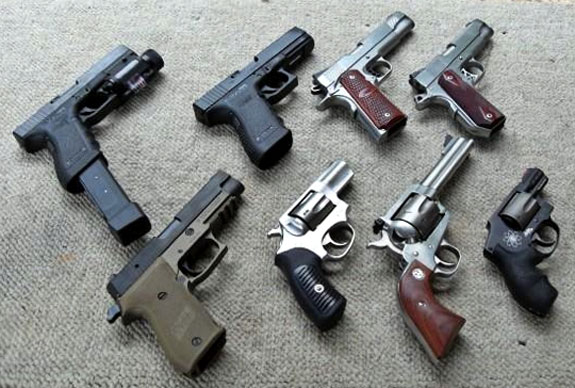
(Photo: Wikimedia Commons.)
By Christie Thompson
ProPublica
In Tuesday’s State of the Union address, President Obama again called for Congress to take quick action on gun control. “These proposals deserve a vote,” he said. “Because in the two months since Newtown, more than a thousand birthdays, graduations, and anniversaries have been stolen from our lives by a bullet from a gun.”
In the two months since Sandy Hook, debate has surged over how to address America’s epidemic of gun violence. In late January, the Senate Judiciary Committee began ongoing hearings on proposals to tighten restrictions on gun sales.
We’ve dug into the NRA’s efforts to block gun control policy, compared spending on both sides of the issue, and laid out five gun laws you probably never heard of. But with so much media coverage, it can be hard to keep facts straight. To help, we’ve compiled some of the best graphics on guns, from where they’re purchased to the laws governing how they’re used.
Gun sales:
 Tracing the national flow of guns, Washington Post, October 2010
Tracing the national flow of guns, Washington Post, October 2010
A 2010 graphic from The Washington Post shows how “states with strong gun laws import [guns] from states with weaker laws.” The map uses 2009 data of firearms recovered by police.
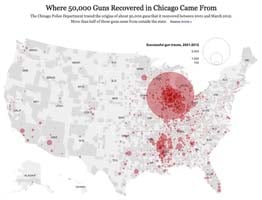 Where 50,000 Guns Recovered in Chicago Came From, New York Times, January 2013
Where 50,000 Guns Recovered in Chicago Came From, New York Times, January 2013
There have been nearly 50 homicides in Chicago already this year, despite some of the strictest gun ordinances in the country. So where are the guns coming from? This New York Times map traces the origins of 50,000 guns recovered by police from 2001 to March 2012.
Gun laws and politics:
 Gun laws in the US, state by state, The Guardian US, December 2012
Gun laws in the US, state by state, The Guardian US, December 2012
Any conversation on regulation is complicated by the huge variation in gun laws from state to state. This Guardian US interactive lays out regulations by state, from concealed handgun laws to background checks.
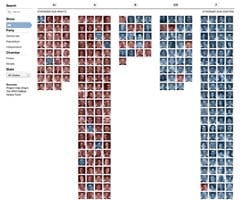 Where Congress Stands on Guns, ProPublica, January 2013
Where Congress Stands on Guns, ProPublica, January 2013
Do you know where your representative stands on gun control? This chart details NRA and ratings and contributions, Brady scores and votes on the 1994 assault weapons ban.
 Gun Rights Campaign Contributions, Slate, January 2013
Gun Rights Campaign Contributions, Slate, January 2013
Find out how much gun rights advocates donated to members of Congress in the last election cycle.
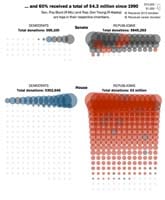 How the NRA exerts influence over Congress, Washington Post, January 2013
How the NRA exerts influence over Congress, Washington Post, January 2013
The Washington Post visualizes which members of Congress “get the most–and least–support” from the NRA.
 This is Your Representative on Guns, The Daily Beast, February 2013
This is Your Representative on Guns, The Daily Beast, February 2013
Input your address and get an overview of your representative’s positions on gun control as well as NRA contributions for each. The Daily Beast is also aggregating gun-related tweets by politicians at @YourRepsOnGuns.
Gun violence:
 The U.S. Shooting Epidemic, The Daily Beast, July 2012
The U.S. Shooting Epidemic, The Daily Beast, July 2012
The Brady Campaign to Prevent Gun Violence estimates a multiple-victim shooting happens once every 5.9 days in the U.S. That totals at least 431 such shootings since 2005. The Daily Beast mapped the Brady Campaign’s data to see where such violence occurs.
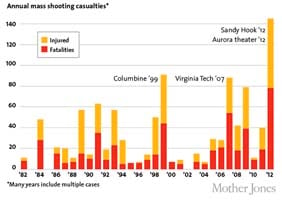 America Under the Gun, Mother Jones, December 2012
America Under the Gun, Mother Jones, December 2012
Over 140 people were killed or injured in seven mass shootings in the U.S. last year. As part of a special report, Mother Jones compiled a series of graphics on the victims of mass shootings, and the spread of looser gun laws across the country.
 U.S. Gun Crime, The Guardian, December 2012
U.S. Gun Crime, The Guardian, December 2012
Gun laws vary across the country, but how much difference is there in gun crime? The Guardian has a state-by-state comparison, charting stats including firearm murders as a percent of all murders, and the number of gun robberies per 100,000 people.
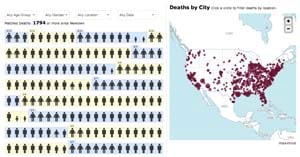 How Many People Have Been Killed by Guns Since Newtown?, Slate, January 2013
How Many People Have Been Killed by Guns Since Newtown?, Slate, January 2013
So far, Slate has recorded at least 1,795 victims of gun violence since the morning of December 14th, the day of the Sandy Hook shooting. Slate is also crowdsourcing gun death reports on Twitter with @GunDeaths. As they point out, “the data is necessarily incomplete,” but they attempt to give a name to each recorded victim.
